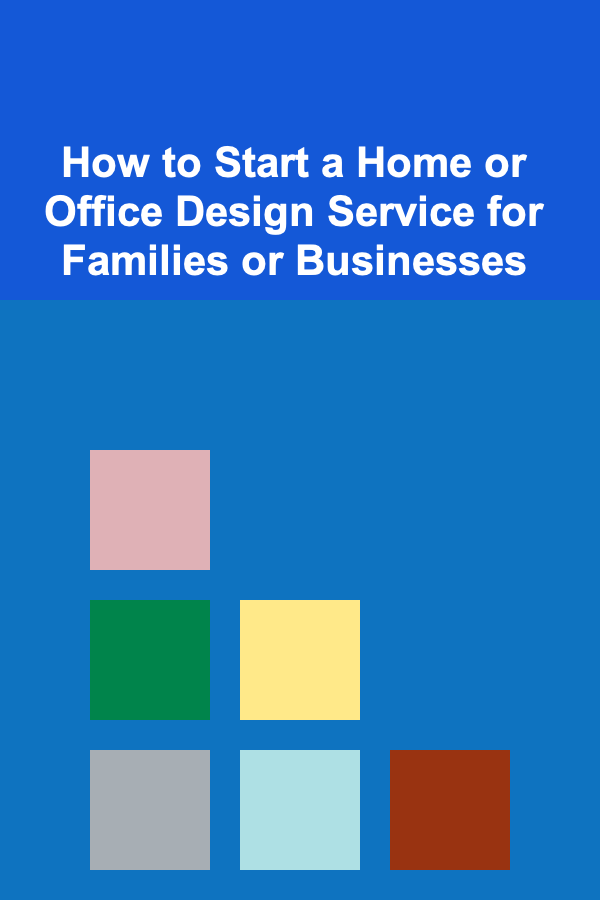
How to Start a Home or Office Design Service for Families or Businesses
ebook include PDF & Audio bundle (Micro Guide)
$12.99$10.99
Limited Time Offer! Order within the next:

Starting a home or office design service can be an exciting and profitable venture. Whether you're passionate about interior design, have a keen sense for organizing spaces, or simply love to help families and businesses create environments that reflect their personalities and goals, this is a field where you can truly make an impact. However, starting such a service requires careful planning, the right skills, and a strategic approach to turn your vision into a reality.
In this actionable guide, we will walk you through the essential steps you need to take to start a successful home or office design service. From refining your niche and building your skills to attracting clients and running your business, here's how you can get started and succeed in this dynamic industry.
Define Your Niche and Target Audience
The first step in starting a design service is to clearly define your niche and identify your target audience. The interior design field is broad, so focusing on a specific type of design can help you stand out in a competitive market.
Actionable Steps:
- Assess Your Strengths and Interests: Do you have a passion for creating stylish homes for families? Or do you excel at designing functional and aesthetic office spaces for businesses? Understanding your strengths and interests will help you determine your niche.
- Research the Market: Look at existing design services and identify any gaps or underserved markets. For instance, you might find that there's a growing demand for sustainable, eco-friendly home designs or corporate office spaces that prioritize employee well-being. A unique selling proposition (USP) will differentiate you from other designers.
- Choose a Niche: You could focus on residential design (homes, apartments, etc.), corporate office design, commercial spaces, or even specialized designs like home staging or smart home integration. Once you've decided on your niche, tailor your marketing, services, and pricing to appeal to your target audience.
Actionable Tip:
Conduct surveys or focus groups to better understand the needs and preferences of your target audience. Whether through social media, in-person meetings, or online forums, gathering feedback will help you fine-tune your service offering.
Build Your Skill Set and Expertise
To establish credibility and trust with your clients, it's important to have the right set of skills. As a home or office design professional, your clients will expect a high level of knowledge and expertise in design principles, materials, and current trends.
Actionable Steps:
- Invest in Education: Whether you decide to pursue a degree in interior design, take online courses, or attend workshops and seminars, continuing education is key. A solid foundation in design principles, color theory, space planning, and materials will give you the technical skills needed to succeed.
- Develop a Portfolio: Start by designing spaces for friends, family, or even volunteer clients. Document your work through high-quality photos and create a portfolio that showcases your best designs. This will be your calling card when attracting potential clients.
- Stay Updated: The design world is constantly evolving with new trends, technologies, and materials. Stay updated by subscribing to industry magazines, following design blogs, and attending trade shows or webinars.
Actionable Tip:
Consider working as an intern or apprentice for an established designer to gain hands-on experience before starting your own service. This experience will also help you build a professional network and learn how to manage clients effectively.
Set Up Your Business Structure
Once you've honed your skills, the next step is setting up your business. This involves legal and financial considerations that are essential for running a legitimate and successful operation.
Actionable Steps:
- Choose Your Business Model: Decide whether you'll operate as a sole proprietor, LLC, or corporation. An LLC is typically a good choice for protecting your personal assets while maintaining flexibility. Consult with a legal or financial professional to determine the best structure for your needs.
- Register Your Business: Obtain the necessary licenses and permits to operate legally in your area. This may include a business license, tax registration, and specific certifications depending on your location and services.
- Set Up Your Finances: Open a separate business bank account and keep your personal finances separate from your business expenses. You'll also want to set up accounting software or hire an accountant to manage your taxes, expenses, and income.
Actionable Tip:
Consider getting business insurance, especially liability insurance, to protect yourself in case of accidents or disputes with clients.
Develop a Pricing Strategy
Pricing your services appropriately is crucial to attracting clients while ensuring that your business remains profitable. Pricing too high can turn potential clients away, while pricing too low can undervalue your work and lead to unsustainable business practices.
Actionable Steps:
- Research Competitors: Look at what other home and office design services are charging. This will give you a general idea of what the market is willing to pay.
- Offer Tiered Pricing: Consider offering multiple service tiers to cater to different budgets. For example, a basic consultation might be priced lower than a full-scale design service, which includes furniture selection and project management.
- Factor in Costs: Be sure to account for any costs related to materials, design software, travel, and subcontractors when calculating your pricing. You don't want to set prices that leave you with little profit margin.
Actionable Tip:
Offer free or discounted initial consultations as a way to entice potential clients to hire you. Use this time to assess their needs, show your expertise, and explain the value of your services.
Market Your Services
Marketing is key to building awareness and attracting clients. In today's digital age, effective marketing involves both online and offline strategies to reach your target audience.
Actionable Steps:
- Create a Website: A professional website is essential for showcasing your portfolio, services, and contact information. Include high-quality images of your past projects, client testimonials, and a blog where you can share design tips and trends.
- Leverage Social Media: Use platforms like Instagram, Pinterest, and Facebook to showcase your work and engage with your audience. Regularly post before-and-after photos, design tips, and behind-the-scenes content to build your brand and attract followers.
- Network with Local Businesses: Attend local events or business mixers to build relationships with real estate agents, contractors, and other industry professionals who can refer clients to you.
- Referral Program: Offer a referral program where existing clients can get discounts or other incentives for recommending your services to others. Word of mouth is one of the most powerful marketing tools in the design industry.
Actionable Tip:
Invest in search engine optimization (SEO) for your website to ensure that potential clients can find you when searching for design services in your area.
Provide Exceptional Client Service
Client satisfaction is at the heart of a successful design business. Your clients should feel valued, listened to, and understood throughout the design process.
Actionable Steps:
- Set Clear Expectations: From the beginning, outline your process, pricing, timelines, and deliverables. Setting clear expectations helps prevent misunderstandings later on.
- Communicate Regularly: Keep your clients updated throughout the design process. Whether through regular check-ins or emails with progress updates, good communication builds trust and helps keep projects on track.
- Ask for Feedback: After completing a project, ask your clients for feedback on your services. This not only helps you improve but also provides you with testimonials that you can use in your marketing materials.
Actionable Tip:
Go the extra mile by offering post-design services, such as helping clients arrange furniture or providing maintenance tips for their new space. This enhances the client experience and encourages repeat business.
Scale Your Business
As your design service grows, you may want to scale your operations. This could mean hiring additional designers, expanding your service offerings, or even opening multiple locations.
Actionable Steps:
- Hire Staff: As you gain more clients, consider hiring additional designers, assistants, or project managers to help with the workload. Ensure that your team shares your vision and commitment to high-quality service.
- Outsource Tasks: For non-design-related tasks, such as accounting or marketing, consider outsourcing to professionals. This allows you to focus on your core competency---designing beautiful spaces.
- Expand Your Services: As your business grows, you may want to offer additional services such as event planning, landscape design, or 3D rendering to attract a broader client base.
Actionable Tip:
Keep an eye on your financials and reinvest profits into growing your business. Whether it's improving your website, attending design conferences, or expanding your team, continuous investment will help you stay competitive.
Conclusion
Starting a home or office design service for families or businesses can be a highly rewarding and profitable endeavor. By defining your niche, building your expertise, and effectively marketing your services, you can create a business that not only serves clients but thrives in a competitive market. Keep refining your craft, listening to your clients, and adapting to industry trends, and your design service will continue to flourish.
Reading More From Our Other Websites
- [Home Space Saving 101] How to Decorate a Small Home Without Sacrificing Style: Small Home Decor Ideas Unveiled
- [Home Staging 101] How to Optimize Your Home's Flow Through Strategic Decluttering for Home Staging in Small Spaces
- [Home Budget 101] How to Identify and Reduce Impulse Spending Habits
- [Home Space Saving 101] How to Double Your Living Space in a Camper: Space-Saving Hacks for Nomadic Living
- [Home Maintenance 101] How to Maintain Your Home's Windows and Doors
- [Organization Tip 101] Top Benefits of Using a Rain Barrel for Sustainable Home Improvement
- [Home Space Saving 101] How to Arrange Furniture for Better Flow in Small Areas
- [Home Maintenance 101] How to Keep Your Home Safe with Regular Electrical System Inspections
- [Personal Finance Management 101] How to Track Your Investments for Tax Season: A Beginner's Guide
- [Soap Making Tip 101] Gift Ideas for Creatives: Why Soap-Making Kits Make the Perfect Handmade Present

How to Create a Cozy Bedroom Using Budget-Friendly Decor
Read More
How to Create Custom Greeting Cards for Special Occasions
Read More
How to Implement a Color-Coding System for Your Papers
Read More
How To Research Egyptian Gods and Goddesses
Read More
Mastering the Art of Negotiating Discounts: Top Tips and Tricks
Read More
How to Craft a Cosplay Prop Checklist
Read MoreOther Products

How to Create a Cozy Bedroom Using Budget-Friendly Decor
Read More
How to Create Custom Greeting Cards for Special Occasions
Read More
How to Implement a Color-Coding System for Your Papers
Read More
How To Research Egyptian Gods and Goddesses
Read More
Mastering the Art of Negotiating Discounts: Top Tips and Tricks
Read More